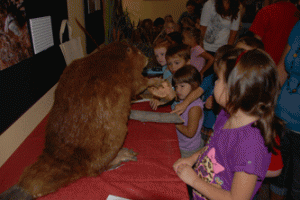It started at Lake Anna in early summer where two child swimmers were attacked by a beaver and sustained lacerations. The beaver was killed and examined and tested positive for rabies, so the girls started treatment. Last month there was a similar report on the Delaware River in New York south of Philadelphia. A boyscout leader was attacked while swimming and the boyscouts saved his life by stoning the beaver to death with rocks. It also tested positive for rabies.
And yesterday an 83 year old woman swimming in Lake Barcroft was attacked. She was rescued by some local fishermen who beat the animal to death with a paddle – and because your question will be the same as mine – yes it was a beaver. Jon & I saw the orange teeth in the severed parts shown accidentally on the news last night. While it is not uncommon to hear stories about beavers being aggressive to dogs in summer when they are protecting their young, this is obviously different. It is extrememly rare for beavers to be a vector for rabies.
The attack, which occurred about 6 p.m. Tuesday, is the second in Virginia since mid-July, when two sisters swimming in Lake Anna in Spotsylvania County were bitten by a 65-pound beaver. That animal was reportedly shot with a BB gun before being transferred to a lab in Richmond, where it was found to be rabid.

The typical way to test for rabies is to slice up the brain of the animal in question, so we obviously don’t do that with humans. In fact we don’t ‘test’ for rabies in humans but just start treating with a series of shots if exposure is reasonably expected. Because the shots tend to be complicated and painful, I assume they are careful about the results.
Last year we had a report in June of a Rabid Beaver attacking three in a Philadelphia Creek which I wrote about here. Obviously within the same general area. So I would imagine the cases are related. I am not at all happy at the idea that this is one more reason to kill beavers, but I suppose, the best possible outcome would be for people to regard beavers with more awareness, and think if something seems unusual to stay away from it, just like you would with a skunk in the daytime, or a skittish dog.
Despite the spate of attacks, the head of a nonprofit organization dedicated to helping people learn about beavers said beaver attacks are extremely rare. Sharon Brown, biologist and director of Beavers: Wetlands & Wildlife, has raised and aided beavers for more than 20 years. She said Wednesday that beavers are peaceful vegetarians who coexist with hordes of other animals living in their habitat and almost never attack humans.
Is there a moral to this story? I don’t know. I guess don’t let your dog swim with wildlife, but any dog whose behavior is going to be controlled probably doesn’t have rabies anyway. Keep a respectful distance from wildlife? I’m not happy with people using beavers for the new jaws movie, but it’s a fact that beavers are wild animals and all wild animals can be unpredictable at times, and even rabid humans aren’t good to be around, so pay attention!







